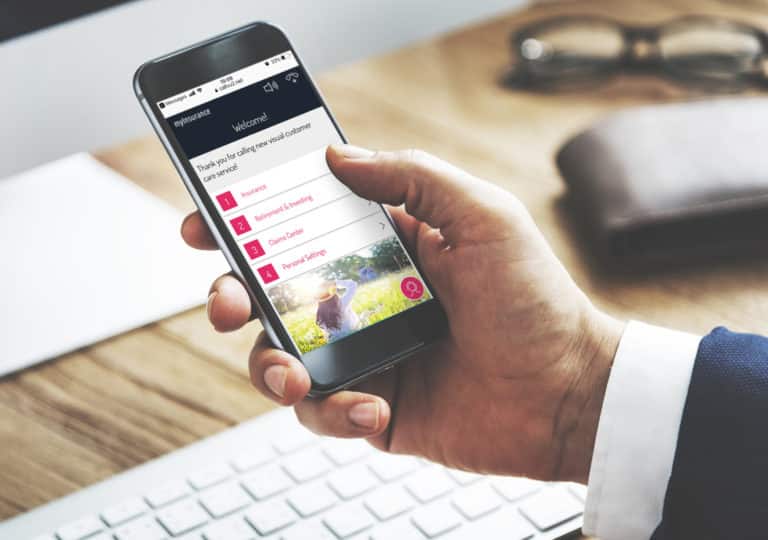One of the most important insights our industry has gained over the past decade is that well-designed, personalized digital self-service experiences can drive better customer satisfaction than live many agent interactions. A 2020 Pindrop study revealed that contact center volume increased 400% on average in 2020, but average calls handled per agent dropped 7% due to remote work. Leading contact centers have raced to address these challenges with a variety of customer experience automation approaches.
Four key digital CX automation strategies are making a big difference: increased call deflection through re-architected customer flows, implementation of digital collaboration technology to reduce/eliminate time spent on critical but repetitive steps, robotic process automation to replace live interactions with chatbots, and forms-based process automation to resolve challenges faster.
Each of these digital CX strategies is an element of customer experience automation — the use of technology to reduce or eliminate manual customer processes for greater efficiency and customer satisfaction. Customer experience automation is about much more than your contact center, of course, but often the utility “torture tests” are in this critical channel.
Let’s examine each of these topics in turn.
Customer Experience Automation Approaches
Call Deflection
When customers solve their problems with methods enabled by process automation, everyone wins. Two of the most effective strategies for call deflection include:
- Visual IVR Path Option: 80% of consumers are better visual than verbal learners. A growing number of companies offer the customer the option of receiving a link to a form-based visual IVR path instead of endless audio menus. By delivering a visual application to the customer’s smartphone, you empower them to more easily choose from among the most common requests: account balance, get claim status, upload photos, etc.
- Create a Common Questions Web Hub: When customers find an easy way to answer their own questions on your site or in your app, call volume drops and satisfaction climbs. For example, creating a page of mini-apps that give people the specific info they seek without having to find it in their comprehensive profiles.
When it comes to implementing visual IVR, successful companies often prefer working with vendors that can provide a variety of executional options versus single-point solutions. This enables more nimble testing while making fewer demands on internal IT teams. WHen we say a variety of executional approaches, we mean firms that can address digital CX challenges WITHIN and BEYOND call center use cases.
Digital Collaboration Technology
This refers to deploying easy-to-use technology that helps agents solve problems faster. The most valuable tools include:
- Video Chat: Enables callers and agents to see one another to ensure improved experience and understanding.
- Co-Browsing/Document Sharing: Here, agent and caller can examine web pages and content simultaneously despite their distributed locations. Guidance from the agent can help users find the information they need.
- Secure Data Collection: This denotes masking customer data entry on the agent’s screen so that key steps like submitting auto payment information can be taken securely on a call.
Companies drive greater savings when they leverage multiple tactics from this list.
Customer Experience Automation and Robotic Process Automation
With Robotic Process Automation or RPA, automated chatbot experiences handle common tasks for customers without driving them to make a phone call. With automation empowering much lower cost structures and no wait times for users, these are an increasingly popular element in a CXM strategy. Call volumes drop, and customers get answers faster. Many companies are now employing such RPA bots as a core element of a customer behavior roadmap.
The first chatbots were quite primitive and the user experience was often embarrassing, particularly for healthcare and financial services companies. The technology lacked finesse and specificity. But times have changed, and conversational ai has dramatically enhanced the quality of customer engagement. Today’s chatbots can accurately answer lots of customer questions. Many companies are finding that they can even contribute more loyal customers — a marketing and sales benefit to CX automation that one may not always associate with customer service interactions.
Customer Experience Automation and Forms-Based Process Automation
Process automation refers to transforming common call tasks for faster and more accurate completion.
- Templated Form Builders: These powerful tools create simple forms for specific purposes – forms that can deploy online, mobile web, apps, and contact center dashboards. Forms can be integrated into customer flows during or in lieu of support calls.
- Real-Time Form Updating: Testing makes it easy to optimize flows to and from forms. No-code tools are great because they enable you and your team to build and optimize without the developer queue.
- e-Sign: When agents can send and receive e-sign forms directly via the user’s smartphone, efficiency grows markedly.
Additionally, by integrating your form builder with your existing data and insights systems like your CRM, you can deliver a highly satisfying personalized experience to every customer. That can greatly enhance your customer retention metrics.
The Way Forward
Now that you know the tools that can address your challenges, it’s time to act. Keep these lessons in mind as you move forward:
- Point solutions are not your only option: A new type of solution called CX Automation Platforms gives you access to all of these tools from a single workflow. The goal of these platforms is to empower you to optimize the entire customer journey using powerful automation technology. With a CX AUtomation Platform, every customer interaction can be more efficient and provide a positive customer interaction.
- Find collaborative partners: Some vendors in our space want you to conform to their lockstep model. Instead, choose a partner that listens to your unique customer support challenges and formulates a business process automation solution that works for how you work.
- Create an efficient deployment plan: Learn how others have chosen and deployed these technologies. Learn from their CX automation experiences.
- Focus on flexibility: No one could have predicted the massive challenges that 2020 brought to contact center leaders. Choose automation tools and partners that give you the flexibility to react to market changes.
For more information about customer experience management and digital CX, visit our website or request a demo today.





